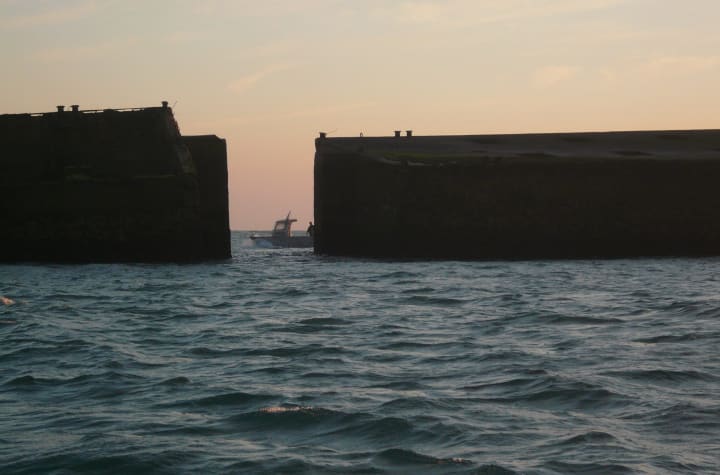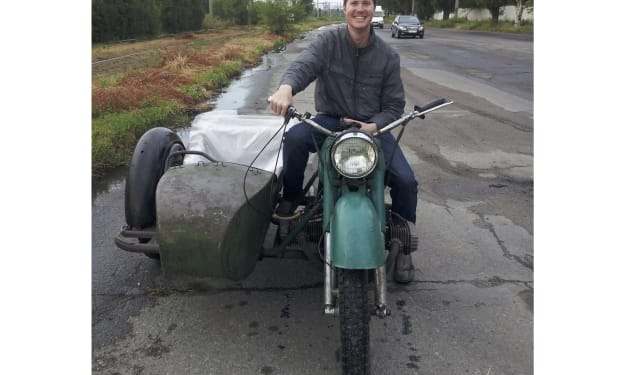A Night at the D-Day Beaches
How many ghosts surrounded us we wondered, anchored within the Old D-Day Mulberry Harbour?

Tours of the D-day beaches are popular, but ours was a bit different.
It was the summer of 2011, 77 years after D-Day. We sailed across on our 27' boat from the Solent in England. We didn’t quite follow in the wakes of all those ships and brave soldiers, sailors and airmen. Our route was simpler.

And we were lucky with the weather.
Firstly we made the 66 mile crossing to the marina in Cherbourg in daylight. Next day we sailed eastwards around the Pointe de Barfleur, past the huge Barfleur (Gatteville) lighthouse. Then we were in the Baie de Seine. We anchored of St Vaast (famous for its oysters) for a night and then the next day sailed on past Utah beach. We found our way through the extensive sandbanks, onward and up the Carentan canal.

Then we were stuck, moored in the Carentan canal for a few days while the heavens emptied on us. But it was rain, not the 82nd and 101st Airborne forces which had rained down on that area in the early morning of June 6, 1944.
We did get to visit Sainte-Mère-Église, which was one of the first towns in France to be liberated. We stood in the town square and saw the parachute memorial, consumed by the history and touched by emotion.
A small and quiet rural community, Saint-Mère-Eglise was of great importance as it straddled all communications to Cherbourg. While nearly 13,000 American paratroops were being dropped under a full moon into the confusion of the surrounding countryside, famously one company was dropped, at about 1:45am, onto the village square and cattle market of this now world-famous village.- Normandie-Tourisme

When the rains finally ceased we went back down the canal to the open sea and continued eastward past Omaha beach, thinking of ‘Saving Private Ryan’ and its realistic depiction of that landing by the US Rangers on that beach. And of course for historical accuracy I should include the US 1st and 29th Infantry Divisions who also played their part.
That day ended with good weather as we reached Gold Beach and a rare chance to anchor inside the remains of Port Winston, one of the two Mulberry harbours which ensured the success of the Allied invasion of Europe.

The red cross in the above picture is approximately where we anchored for that night.
The area is wreck-strewn.
As it now is
From our electronic chart:

The Mulberry harbours were an ingenious idea and used a novel concept to enable around the clock all-tide operation, landing 12,000 tons a day of matériel. Two were constructed in secret, towed in sections across the English Channel and assembled off the D-day beaches.
The tides at the D-Day beaches can range over 7 metres, and that posed major design problems. The solution was first developed for the Mulberry harbours by a Scottish engineering consultancy. Also, long floating roadways were required to move the cargo ashore and these were conceived by Major Allan Becket who also designed special anchors with high holding power (2,000 anchors were required).
Today we see marinas all around the world which use the principle of floating pontoons and piles that were first conceived for D-Day.

On the afternoon of 6 June 1944 (D-Day) over 400 towed component parts (weighing approximately 1.5 million tons) set sail to create the two Mulberry harbours. It included all the blockships (codenamed Corncobs) to create the outer breakwater (Gooseberries) and 146 concrete caissons (Phoenixes). - Wikipedia
Over the following days old ships were towed across the English Channel and sunk to provide an outer breakwater and protect the floating docks and roadways.
Harbour ‘A’ off Omaha beach was badly damaged by bad weather within 2 weeks of construction, but Harbour ‘B’ — Port Winston — survived. Harbour 'A' was later repaired.
The concrete is all that remains today.

We’d been careful with our anchoring as there was a wreck nearby, but all was well and we enjoyed a peaceful night with the ghosts who did not disturb us.
A beautiful dawn
The next morning was beautiful and the skipper (now my First Mate on my boat) snapped a Frenchman out trying to catch his breakfast.

Onwards
After breakfast we moved on to Courseuilles-sur-Mer (Sword Beach) where we could safely leave the boat at a mooring on the Orne River and catch a bus back (in the rain) to visit the superb D-Day museum at Arromanches. The museum has a large, intricate and fascinating model of the Mulberry harbour at Gold Beach.
And backwards
By then it was time to return to England. That turned out to be a tough sail in a twenty seven footer but all went well.
And now, every time I tie up at a floating dock, I think of the Mulberry harbours and how they ensured a successful liberation of Europe.
There's a saying that 'the sea washes away all ills'.
It's taking a long time at Arromanches.
There’s much more about this fascinating piece of history at Wikipedia.
***

Canonical: This story was first published in Medium on 9 September 2022 [edited]
About the Creator
James Marinero
I live on a boat and write as I sail slowly around the world. Follow me for a varied story diet: true stories, humor, tech, AI, travel, geopolitics and more. I also write techno thrillers, with six to my name. More of my stories on Medium






Comments
There are no comments for this story
Be the first to respond and start the conversation.